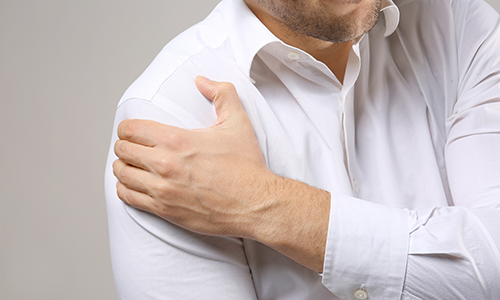4 common causes of shoulder pain
- Overview
From lifting weights to brushing our teeth or typing at a computer, we use our shoulders more often than we realise. When you start to feel pain in your shoulder it can affect many of the day-to-day tasks that we take for granted.
Made up of a number of component parts, the shoulder is a complex body part and while pain felt in the shoulder can originate from the shoulder, it can also come from elsewhere, such as the neck.
Diagnosing the source of shoulder pain requires a detailed account of the pain, together with an expert examination and sometimes xrays or specialist scans are used to confirm a diagnosis, or provide further information. But here's four very common causes.
1. Shoulder arthritis

We more commonly hear about arthritis of the hips and knees, but it's possible to develop arthritis in any joint. There are two main kinds of arthritis in the shoulder: Gleno-humeral and Acromioclavicular.
Gleno-humeral joint arthritis
The gleno-humeral joint (GHJ) is the main ball and socket joint in the shoulder and athritis here is common. It doesn't always cause significant pain and functional impairment, but it can. While there are a number of different types of arthritis, the most common is the ‘wear and tear’ type (osteoarthritis) which occurs as people age.
If you're found to have GHJ osteoarthritis, the initial treatment is often to modify the activities that cause the pain and take over-the-counter painkillers. In some people a cortisone injection into the joint may provide relief, although it's not usually long lasting.
Alternatively targeting the nerve which supplies some of the feeling to the joint (suprascapular nerve) with an injection may improve the pain. This may be particularly helpful in those patients not suitable for surgery. Ultimately, where symptoms persist, surgery may be required.
The nature of the surgery will depend on the individual circumstances. Arthroscopic surgery may be helpful in select cases, particularly if there is irritation from loose bone or tissue floating around the joint. The majority of surgery involves replacing the arthritic joint with an artificial one. There are various types of shoulder replacement, with the most appropriate depending on individual patient circumstances.
The acromioclavicular joint (ACJ) is the joint formed where the clavicle (collar bone) meets the acromion (shoulder blade). It is a common joint affected by osteoarthritis however for many people it doesn't cause significant symptoms.
If ACJ arthritis is a problem, then there are a number of options. Initially, modifying activities may be sufficient to control the symptoms. If not, then an injection and ultimately an operation may be advised. The operation usually consists of trimming the end of the clavicle so that the two bone ends (clavicle and acromion) don't rub against each other and generate pain.
2. Subacromial impingement
Subacromial impingement is a common cause of shoulder pain. It typically describes pain in the shoulder that comes on when reaching out, up, or behind. It tends to be a sudden, catching type of pain. It can occur from the shoulder being held in a poor position, sometimes following a minor injury. It may also be due to a structural problem with the shoulder such as a prominent bone spur on the underside of the acromion which catches the sliding tendons below as the shoulder moves.
The majority of subacromial impingement settles with specialist physiotherapy and cortisone injections, however in some cases surgery is required. The surgery is performed as a keyhole procedure and involves taking away any bone spurs and clearing out the inflammatory tissue present.
3. Frozen shoulder
A frozen shoulder is also known as adhesive capsulitis and constitutes a stiff shoulder which is often painful. The pathology involves the capsule (soft tissue envelope) that surrounds the shoulder joint which becomes thick and stiff preventing normal shoulder movement. Because the ball and socket joint isn't able to move normally, shoulder dysfunction can occur with pain developing in the neck and around the shoulder blade.
For some people simply knowing the diagnosis is enough, provided the frozen shoulder doesn't hinder them unduly in day-to-day tasks. Where function is significantly affected, there are a number of treatment options available. A simple cortisone injection into the shoulder can provide pain relief and sometimes an increase in shoulder movement. Other options include a special injection to try and gain a greater improvement in shoulder movement by injecting a larger volume of fluid to stretch and tear the shoulder capsule. This is known as hydrodilatation.
The final option is surgery. Surgery is performed either as a manipulation under general anaesthetic to tear the shoulder capsule and free-up the shoulder, or as keyhole surgery to release the stiff tissues of the shoulder under direct vision. Whichever method is employed, it is important to keep the shoulder moving after the surgery to prevent it from re-stiffening.
4. Rotator cuff tear
The rotator cuff comprises a number of muscles (supraspinatus, infraspinatus, subscapularis, teres minor) deep in the shoulder which function to move the shoulder. Tears in these tendons can occur from a specific injury or as a result of the tendons gradually thinning with age. The tears themselves may cause pain but may also be asymptomatic.
Depending on a patients’ individual situation and the type, location, and size of the tear, specialist physiotherapy or surgery may be advised. Because the specific treatment of rotator cuff tears varies from one patient to the next depending on individual factors, review by a specialist is important to ensure the most appropriate management.
Last updated Monday 19 August 2024
First published on Wednesday 3 April 2019

